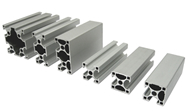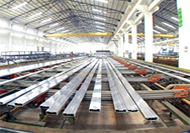Tempers
All aluminum alloys, regardless of product form, are classified as either heat-treatable or nonheat-treatable, depending upon the method used to attain their maximum strength.
- Nonheat-treatable alloys: 1xxx, 3xxx, and 5xxx series develop strength characteristics through cold work after extruding, if the section shape permits.
- Heat-treatable alloys: 2xxx, 6xxx, and 7xxx series, which have the highest strength of all aluminum alloys, attain their maximum strength through controlled heat treatment, sometimes at the extrusion press and sometimes in a separate furnace.
The modification methods applied to heat- and nonheat-treatable alloys are listed in the Temper Designation System below.
F |
As Extruded |
No special control over thermal conditions or strain-hardening; no mechanical property limits |
O |
Annealed |
Thermally treated to obtain the lowest strength temper |
H |
Strain-hardened |
Cold working used to increase strength and hardness |
T |
Thermally Treated |
Thermally treated to produce stable tempers other than F, O, or H |
A complete alloy-temper designation reads like this: 6063-T5. This designation indicates a particular alloy of the 6xxx series (Mg and Si), which is thermally treated by being cooled from an elevated temperature and artificially aged.
Typical Tempers for Extrusions
O Fully annealed.
H112 Strain-hardened; used for nonheat-treatable alloys.
T1 Cooled from an elevated temperature and naturally aged.
T4 Solution heat-treated and naturally aged.
T5 Cooled from an elevated temperature and artificially aged.
T6 Solution heat-treated (which may be accomplished for some alloys in-line
at the extrusion press) and artificially aged.
  back back
|





 Corporate Profile
Corporate Profile